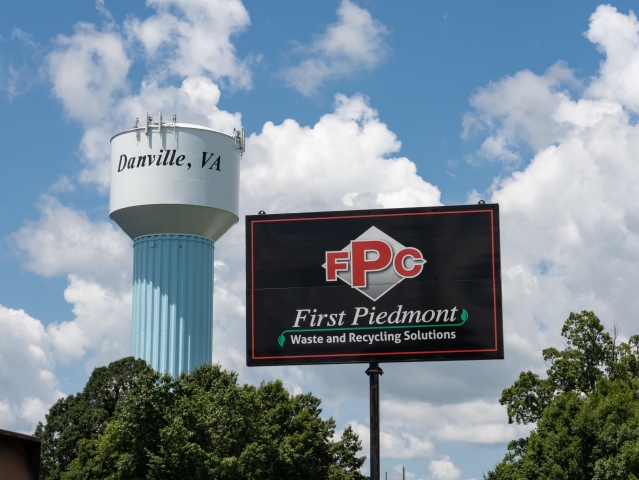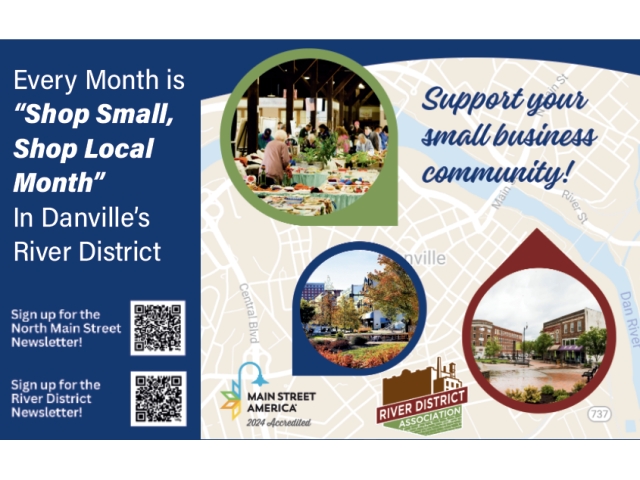
First Piedmont Corporation Landfill signage near the entry to their landfill. By Paul Liggitt Photo & Video
Trash, junk, garbage, waste – whatever you decide to call the material that is of little value, there is a lot of it in any populated metropolis. No modern, semi-affluent society, large or small, lives among its own trash. In early times, way early, populations lived off the land and what it provided. They used a much higher percentage of the animals they hunted and the plants they harvested. Even though their ingenuity was substantial, they were limited. That was then and this is now.
Populations have increased and mankind’s intellect has developed. People discovered ways to harvest more of the natural resources on and in the earth, and invented new materials by combining or altering existing materials and elements, which in turn created products that increased efficiency in living. It is a great time to be alive. The innovations we have seen in the recent past and the advent of new technologies and innovations will undoubtedly bring another wave of progress. However, one thing is a constant with all this progress: the trash still needs to be taken out. In a growing community like Danville, First Piedmont Corporation has been meeting the needs for industrial waste management in a comprehensive and responsible way since 1969.

Goodyear has been an anchor industry for Danville for years, and when the company was notified that the Danville municipal landfill would no longer accept its industrial waste, the problem was mentioned to an industrial lubricants salesman named Ben J. Davenport, Jr. That is when the idea for First Piedmont Corporation was born. His entrepreneurial spirit was energized and he got to work to solve Goodyear’s waste collection and disposal needs. Davenport also recognized that as Danville’s industry grew, other businesses would require a managed waste program. Land was purchased and permitting began for First Piedmont’s landfill, which opened in 1972. Today, First Piedmont continues to service Goodyear and many other businesses in the southside of Virginia and North Central North Carolina with turnkey solutions to their industrial waste needs.
Landfills have been around since 1937 and, practically speaking, are still a relatively low impact way to manage waste. First Piedmont owns and operates its own 250-acre landfill just east of Danville. What the public doesn’t realize, however, is the amount of engineering and science that is built into the construction of the “cells” that hold the waste. The geology, biology, and many other “ologies” that go into the successful design, construction, maintenance, and day-to-day operations of the landfill are extremely sophisticated. It is hard to imagine that digging a hole in the ground to put trash into and then covering it with dirt could be so complicated.

Nick Setliff, vice president and chief operating officer at First Piedmont, credits his training in software engineering with equipping him to manage the myriad of challenges First Piedmont faces. “Problem solving is one of my passions, “ he said as he described the intricacies of the process. The landfill has ample soil, used as cover material for each layer of compacted waste, and has a direct line that pipes leachate from the landfill cells to the Danville wastewater treatment facility. “Anytime water touches trash it is considered leacheate and has to be specially treated,” he explained
Before 1980, just about anyone could have a landfill. “Dig a hole, put trash in it, and cover it up” was pretty much what was happening. But the 1980s saw the rise of regulatory agencies like The Department of Environmental Quality (DEQ) in Virginia. They created regulations that require a level of engineering, and monitoring, that First Piedmont has kept pace with over the years. From local building permits, erosion, and sediment control, to transfer station monitoring and processing of specific industrial waste, First Piedmont is highly regulated. Household and food waste are examples of waste that must be transferred to other municipal landfills.

To get an industrial landfill up and running today is an eight- to 10-year process and could cost millions of dollars, according to Setliff. The fact that First Piedmont owns its landfill is a testament to the forward-thinking leadership of Davenport and his team. Not only that, but First Piedmont’s development of a cell-lining system and material for its landfill has become an industry standard for other landfills. There are other options to landfills, and if a First Piedmont customer has a zero landfill policy, incineration is one, but at four to five times the price of normal disposal in the landfill.
The broad categories of waste that need to be managed are municipal, commercial, industrial, and finally special waste that requires special handling, involving disposal or hauling. One such example of “special” might be asbestos that is collected, buried, and covered, but is marked with coordinates in case any future excavation is required. Another example is an industrial by-product that heats up to around 400 degrees when it gets wet, which is certainly problematic if mixed in with other combustible materials. That specific waste is mixed with ash, then wetted. Once it has gone through the heating process it is covered with dirt and buried in an area void of combustible material. There are precise locations of specific materials within the 250 acre landfill. Department of Professional and Occupational Regulation (DPOR) trained and certified First Piedmont employees are also onsite at transfer stations and the landfill, where they monitor the type of waste to ensure compliance with regulations.

The advent and adoption of modern technology is one of the prime reasons that First Piedmont has kept pace with the growth of Danville and the region. The company utilizes a satellite mapping system that can accurately create a 3D topographic map and aid in creating depth measurement charts. With those charts and data, First Piedmont can efficiently determine how much dirt to move in a particular location when constructing the different cells. The company also manages up to 170 vehicles with a telematics system; a real-time tracking and monitoring system for trash trucks. It tracks and identifies vehicle fault codes to alert maintenance to current and potential repair needs. First Piedmont was also an early adopter of compressed natural gas (CNC) for some of those Big Red Trucks on which they want their customers to rely.
Setliff is encouraged by the steady growth in the construction and manufacturing industry throughout the region in the last three to five years. First Piedmont can be a qualified, experienced partner to help navigate particular waste management challenges, and offer a free consultation for businesses.
Setliff said the company’s driving force is to be a good neighbor. “We have close to 180 employees, so whatever we do as a company affects our work family and our broader community.” Local leadership and management means that First Piedmont Corporation is invested in serving the needs of the region, because they live and work there, too.

108 S. Main Street
P.O. Box 1069
Chatham, Va. 24531
(800) 476-6780
www.RelyOnRed.com
































































































